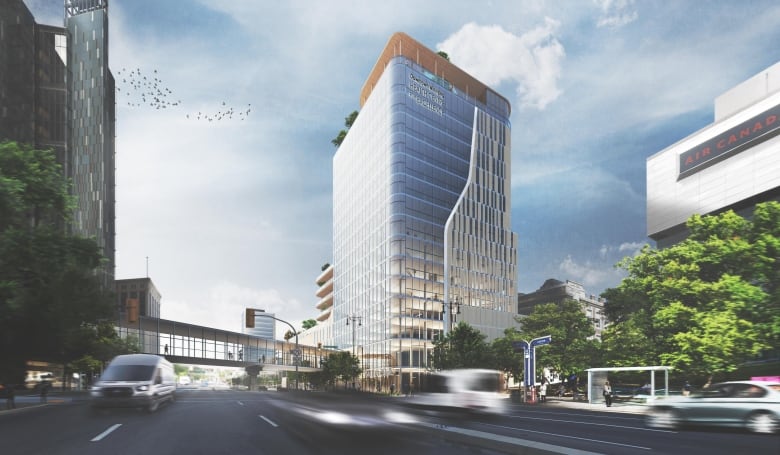Slow post-pandemic recovery continues with national downtown office vacancy rate at 18.9%.

At 11 a.m. on a Wednesday, the office crowd is just starting to trickle in to Eat Trattoria, a lunch spot located in the heart of Calgary’s Plus 15 skyway network.
It’s a far cry from a few years ago, when the downtown café would already be full with workers trying to beat the lunch rush.
“We still do a good lunch hour, but it really is a lunch hour that’s now 45 minutes rather than one that was about an hour and a half,” said Matthew Batey, chief operating officer of the Teatro Restaurant Group, which owns Eat Trattoria and other downtown restaurants.
Businesses in downtown Calgary are still making do with a relatively thin crowd these days, as the pandemic-era trend of working from home compounds a downtown exodus that first began during the 2014 oil price crash.
They’re not the only ones.
Calgary’s downtown offices are the emptiest in the country, but most urban centres are still struggling to varying degrees to get back to where they were before the COVID-19 pandemic arrived in early 2020.
According to commercial real estate firm CBRE, the national downtown office vacancy rate is hovering at 18.9 per cent — the highest in about the last 10 years — with some of the highest vacancy rates in Edmonton, London, Ont., and the Waterloo Region in Ontario.
Without a daily crush of office workers providing a reliable customer base, downtown businesses and restaurants across Canada say they’re having a hard time making ends meet.
In search of federal support, business leaders and advocates were on Parliament Hill in Ottawa this week asking for an extension on COVID-era business loans, along with dollars to fix decaying downtown infrastructure.
“Many of our downtowns across Canada have crumbling sidewalks or trees missing, and so there’s a real opportunity for some simple things, but also some bigger visionary projects … that are going to make sure our downtowns are strong for generations to come,” said Kate Fenske, chair of the International Downtown Association Canada.
But injecting new life into Canadian downtowns isn’t just about patching holes that have emerged post-pandemic, Fenske said. Instead, she said, a conversation is underway at a national level about how to build downtowns that make sense for the way we live now.
“Workers absolutely play a key part in the downtown community, but we can’t rely on workers alone,” said Fenske, who is also CEO of Downtown Winnipeg Biz.
“What is that new vision for downtown? It’s about people that are here beyond the nine-to-five.”
Safety concerns a barrier
In Fenske’s home city of Winnipeg, the downtown’s post-COVID recovery has been hampered in part by concerns about safety.
During the pandemic, issues of homelessness and addiction both worsened and became more visible without the city’s typical buzz of activity. Absent a regular crowd providing a sense of safety in numbers, many people have stayed away from the core altogether, which has exacerbated the situation.

One partial solution has come in the form of the city’s Downtown Community Safety Partnership.
Launched during the pandemic, the service patrols downtown Winnipeg 24/7, responding to distress calls, providing wellness checks and helping people sleeping rough to access food, shelter and other help, like addiction services. It also provides escorts for Winnipeggers who are worried for their personal safety.
Greg Burnett, the group’s executive director, said safety is a two-way street. While issues such as homelessness and mental illness can make the public feel unsafe, he said it’s often the people experiencing those problems who are most at risk.
His group aims to help people on both sides of that equation, whether it’s a person in distress or a downtown worker who wants a safe walk home.

“Our main reason to exist is to encourage everybody downtown that they’re in a safe and healthy environment,” Burnett said.
Fenske said the problem isn’t unique to Winnipeg, as cities across Canada face safety “perception” problems on their road to recovery. To get at the root of the issue, she said, all levels of government need to fund and find solutions for the intertwined problems of mental illness, addiction and homelessness.
Push for Winnipeg development
To bring back that safety-in-numbers feeling, though, work is also underway in Winnipeg to encourage people to return downtown for reasons that go beyond a nine-to-five desk job.
Mark Chipman, executive chair of True North Sports and Entertainment, which owns the NHL’s Winnipeg Jets, has described the city’s downtown as being in a “humanitarian crisis.” He’s also put his money where his mouth is, investing big to upgrade the hockey arena, and build office towers, apartments, a hotel and community space.

True North has also put forward a $550-million proposal to renovate the Portage Place mall across from the Canada Life Centre arena, where the Jets play, and build a medical office tower and more apartments.
The proposal dovetails with another project by the province’s Southern Chiefs’ Organization, which is behind a $130-million transformation of the former downtown Hudson’s Bay building into a mixed-use project called Wehwehneh Bahgahkinahgohn.
“It’ll be a place that people love to be. A place for Indigenous peoples. It’s their home, and it’s a place they can feel welcome,” Grand Chief Jerry Daniels of the Southern Chiefs’ Organization said during a tour of the former Bay building earlier this year.

Empty offices, closed shops plague some Canadian cities
Some Canadian city centres are struggling post-pandemic with empty offices and low foot traffic, forcing businesses to close. Advocates and business leaders are asking Ottawa for help as they try creative solutions to save their downtowns.
Embracing the new in Calgary
Perhaps no city has embraced the idea of building back differently quite like Calgary. The city got a head start on the downtown vacancy problem when oil prices crashed in 2014, leading to business closures, consolidations and layoffs.
When it became clear that the number of office towers sitting empty was taking a big hit out of the local tax base, the city devised a sweeping billion-dollar plan to revitalize the core.
The most headline-grabbing element so far has been a push to convert empty offices into homes, hotels and university spaces. At a news conference this week, the city announced the latest developments to get a green light: two residential projects and one hotel.
In all, the city now has 17 projects in the pipeline — including 13 active projects and four under review — that are expected to create 2,300 new homes and cull more than two million square feet of vacant office space.

“There’s a reason Calgary is the talk of the town, and it’s because of statistics like this,” Mayor Jyoti Gondek said at a news conference this week.
While Calgary built a downtown that worked well at a specific point in time, Gondek said, that time no longer exists.
“The more mixed-use we do downtown, the better able we are to combine housing with employment hubs, with recreation and all of the other many, many things people do in their daily routine, the stronger our downtown will become.”
The office conversion program is being watched closely by cities throughout North America, and some cities like Ottawa have embarked on a similar push.
“People are watching us from around North America, you know, from New York state to New Orleans to Los Angeles, who are just going into this work-from-home, high-vacancy phenomena,” said Greg Kwong, regional managing director in Alberta for CBRE. “Hopefully we can be a shining star [and] provide some key performance metrics that are beneficial to other cities.”
Still, the firm noted in its latest office vacancy report that the number of feasible office conversion projects is limited and that conversions alone can’t be a silver bullet.

While Canada’s downtowns share many challenges, each one is different and will have to find its own way forward. How that happens — and how quickly — remains to be seen.
“I’ve been in the commercial real estate sector for 38 years now, and all I do know is one thing: The only constant is change,” Kwong said.
*****
Credit belongs to : www.cbc.ca
 Atin Ito First Filipino Community Newspaper in Ontario
Atin Ito First Filipino Community Newspaper in Ontario






